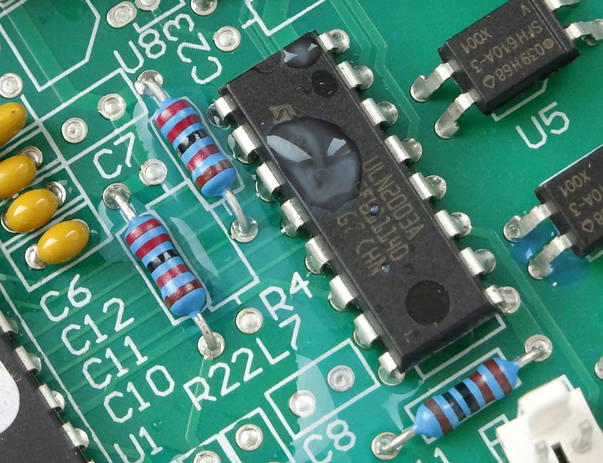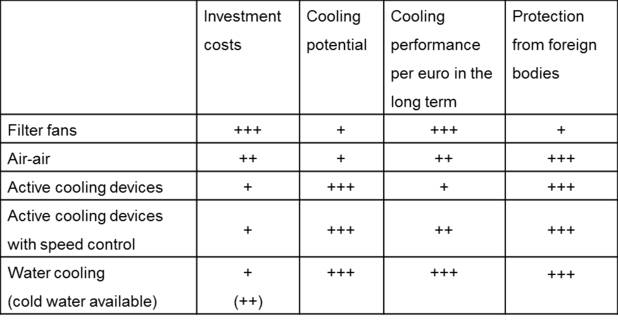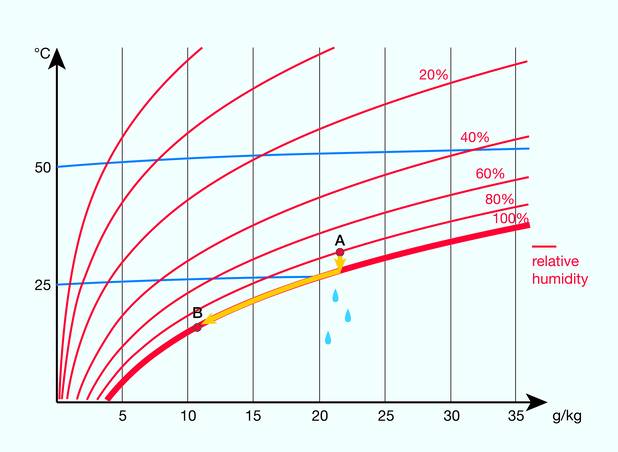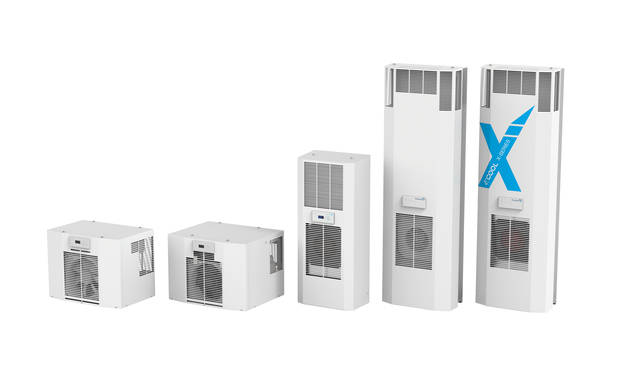The well-tempered electrical enclosure
With production becoming increasingly intelligent, there is a need for more wiring and control technology in electrical enclosures. They heat up from the dissipation from the circuits installed results inevitably in a higher interior temperature. This article explains why uncompromising cooling is not always the best solution for keeping the temperature in electrical enclosures at an optimum level and also examines which solution is best for the customer’s requirement.

Depending on the season of the year and the environment, cooling electrical enclosures can be a challenge particularly when the ambient temperature is significantly higher, as it is in foundries or steelworks, for example. At best, an excessively high temperature in the enclosure results in a temporary shut-down of the circuits. At worst, there is a threat that components will fail completely. As machine availability has the highest priority in manufacturing companies, the temporary interruption to production this incurs is not an acceptable scenario for modern production sites. Opening the door of the electrical enclosure is a quick solution. However, this means that the financial problem develops into a risk to the workforce – and literally opens the door to damage and contamination. So, what is to be done? The first thing is to determine the target temperature of the electrical enclosure.
Extreme cooling is neither necessary nor appropriate
The generally accepted assumption is that the optimum temperature for the interior of an electrical enclosure is around 25°C. Using this as a benchmark means that in the summer a wide range of temperatures needs to be covered. Particularly in southern Germany, the outside temperature can reach and exceed 35°C in two to three of the summer months.
Is it really necessary to cool an electrical enclosure down to 25°C? Semi-conductor research has revealed, for example, that electronic components tend to last longer if temperatures are kept lower. So, does that mean as a general rule of thumb that the colder they are, the better? The temperatures recommended by manufacturers vary: for example, the temperature configured for the maximum life expectancy given for some fans is 40°C. However, how much "improvement", in terms of component life expectancy, "colder" would achieve is a matter of speculation for customers. There are other factors in electrical enclosures for consideration, such as the risk of condensation and the cost of energy. As a specialist for the thermal management of electrical enclosures, Pfannenberg's view is that maintaining a stable and not necessarily low temperature in 2 the enclosure is important for achieving optimum cooling. The ideal temperature for an electrical enclosure recommended by Pfannenberg is approximately 35°C. This not only protects the components but also minimizes the risk of condensation and cuts energy costs.
On the other hand, relying "only" on maximum cooling cancels out the benefit of a longer component life with higher condensation levels and increasing energy costs. When the temperature inside the electrical enclosure is higher, it is mostly cooled automatically by the surrounding air, straightaway cutting the energy required for cooling. Furthermore, this stops condensation, which has the potential to damage the electronic components, from forming in the enclosure. This will happen if the enclosure is the coldest element in the room, primarily in the housing. Everyone is familiar with this phenomenon from the way droplets form on the metal surface of ice-cold drinks cans in the summer.
A cooling circuit removes humidity from the air, lowering it to below that of the surrounding air. Nevertheless, even closed electrical enclosures exchange air with the environment. The warm humid air enters the enclosure and is dehumidified. The target temperature in the enclosure should therefore be higher than that expected for the surrounding air and this requirement is more likely to be satisfied at 35°C than at much lower target temperatures.
Depending on the case scenario, other target values could also be helpful. For example, this is why Pfannenberg's cooling devices are fitted with an active condensation evaporation system which allows cooling to very low target temperatures. The condensation evaporates and is dissipated into the surrounding air. Which cooling solution is best suited to which application depends on local requirements and circumstances. Table 1 shows a simple scale of ordinal values for assessing the various cooling concepts which are described below.

Filter fans and air/air heat exchangers
Over a long period, filter fans are the most cost-effective means of thermal management in electrical enclosures, provided the ambient air is significantly cooler than the target enclosure temperature as only this will give a sufficiently high cooling potential. As the filter fans permanently draw in possibly contaminated air from the surroundings, effective filter technology is essential. For particularly sophisticated applications, some filter solutions are used which offer reliable protection from extreme environmental conditions and even from hose water.
Air/air heat exchangers also require a lower outside temperature. Unlike filter fans, they have the advantage that the air circuits are separate so no outside air is sucked into the electrical enclosure. Instead, the internal fans circulate the air in the enclosure. The circulating air is cooled with the outside air running separately through the heat exchanger. Air/air heat exchangers thus support active cooling solutions.
Active cooling devices and air/water heat exchangers
Active cooling devices which also work with separate air circuits are another option. The air is cooled actively through a cooling circuit giving a high cooling potential which remains stable even at summertime temperatures. Speed-controlled cooling devices are a special form of this option. The components have an intelligent control system which can adjust to the heat load of the electrical enclosure. The benefit of this is that only as much cooling as is needed is ever produced, with longer component lifetime and higher energy efficiency as a result. Combined with a target temperature of approximately 35°C, this provides efficient and gentle cooling which also improves the life expectancy of the electronic components.
Air/water heat exchangers on the other hand use cold water for thermal management. They can provide very effective cooling completely independently of the ambient conditions. Furthermore, the cooling unit does not take in any ambient air. This means that air/water heat exchangers can also be used in very dirty environments. Although this solution requires higher investment for the pipework and the provision of cold water (chiller units), they often pay off in the long term. Their benefit is that the actual cooling is carried out wherever the chiller is installed and away from the electrical enclosure. This approach allows cooling for all the thermal management devices to be bundled together. As large cooling devices are physically more efficient than small ones, the balance of cooling to energy costs is much better, and any investment pays off over time. If there is already cold water available, for tool cooling, for example, air/water heat exchangers are a very cost-efficient alternative.
The risk of condensation
The biggest risk for the electrical enclosure is a short-circuit due to water droplets, which can often destroy elements of the circuitry. The most likely cause of water entry is however not external factors such as cleaning or leaks in the roof. Instead, just a small fluctuation in temperature can mean that droplets or condensation form. For the prevention of condensation, it is important to understand what causes it. Only then is it possible to set up effective countermeasures.
Let us take as an example an electrical enclosure which is two meters high, one meter wide and 0.5 meter deep. If the relative air humidity is 80% and the temperature is 30°C, the air will contain approximately 25 milliliters of water. If the temperature falls to 15°C, the air can only hold around 13 milliliters at the same humidity.
The other 12 milliliters condense. That does not seem to be a lot at first. However, with the natural movement of the air, this quantity concentrates at the coldest parts of the electrical enclosure. One milliliter is equivalent to approximately 10-20 droplets, making 120 to 140 droplets in total.
In most cases, metals conduct heat better than plastic. For this reason, metallic surfaces feel cooler because body heat dissipates on them faster. The same principle means that air also cools faster on metallic surfaces. This is where condensation starts to form. The scenario is a conceivable one: a production facility cools down to 15°C overnight. In the morning, the air is heated by the sun shining in. With the windows open, enough damp and warm air enters from the outside to raise the relative humidity to 80%. If this warm air hits the circuitry in the not yet active electrical enclosure, condensation will form. In nature, this effect is known as morning dew, but in an electrical enclosure it is anything other than desirable.

Heating or cooling
Fortunately, elements in a circuit heat up as they are used. Normally, therefore, no condensation will settle on them. Nevertheless, it is advisable to examine the application thoroughly. One means of combating condensation is to lower the humidity in the air. An active cooling device itself cools the air in the device down to 10-15°C. The condensation thus created is transported outside. As electrical enclosures are not air-tight, a cooling device will dehumidify the air in them permanently. Normally, if the doors are closed, the air humidity falls steeply, so less condensation results.
If no cooling device is connected, the best way of avoiding condensation is a stable minimum temperature. Electrical enclosure heating ensures that the air temperature within the enclosure does not fall below that outside, preventing condensation settling on the cold housing and the installed semi-conductors overnight. If the temperature rises as the enclosure starts working, the heating automatically switches off again. Pfannenberg uses PTC elements for this which automatically regulate their resistance, and thus their heating capacity, in response to the temperature.

Careful combination is paramount
Thermal management is a simple task, but it has to be approached in the right way. As with air conditioning in a room, "colder" is not necessarily "better". Thanks to well-thought-out condensation management, modern cooling devices can also achieve quite dramatic target temperatures in electrical enclosures. However, unnecessarily high energy costs are a consequence of this. Even if these are ignored, high fluctuations in temperature can represent a significant risk for the electrical enclosure, due to condensation formation, for example. Determinedly taking just one factor into account is not right for every instrument. The well-tempered electrical enclosure is the outcome of a careful coordination of all the relevant factors.
| Opis | Język | Format | Rozmiar | Do pobrania |
|---|---|---|---|---|
Technical Report: The well-tempered electrical enclosure |
|
630 KB | Do pobrania |
